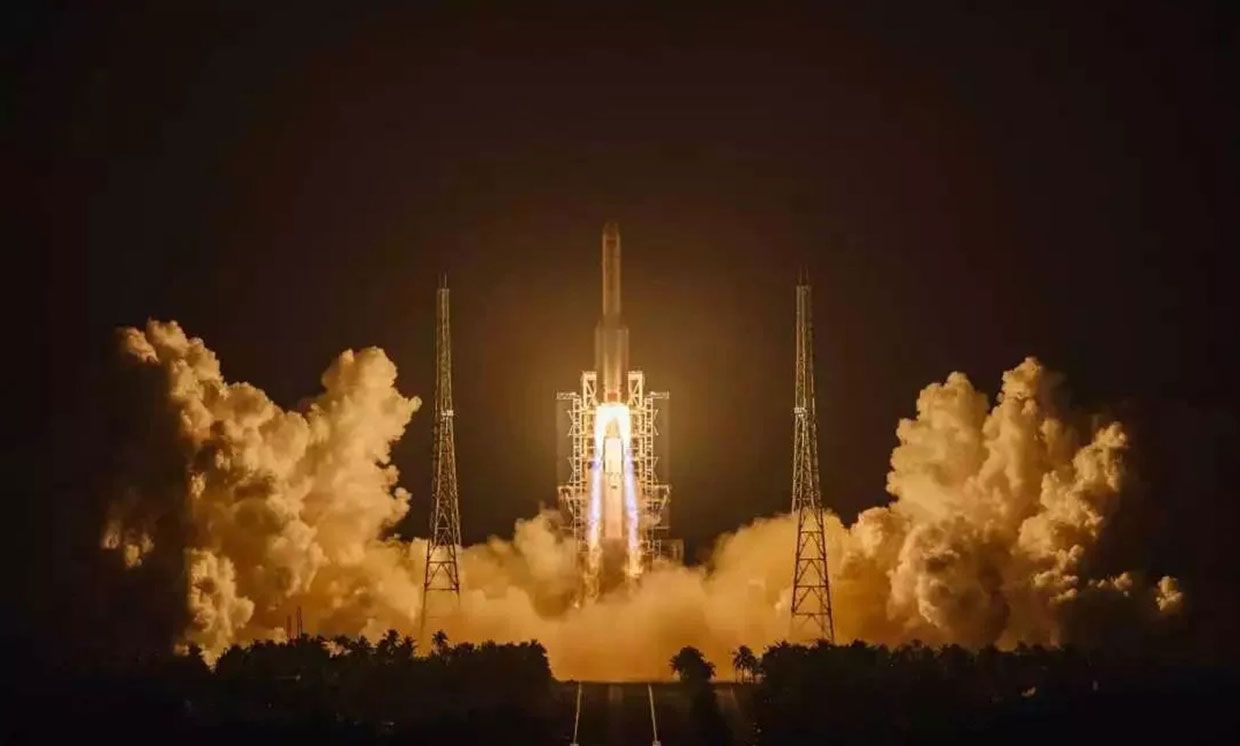Here’s Where and How We Think China Will Land on Mars
China aims to become only the second country to land and operate a spacecraft on the surface of Mars (NASA was first with a pair of Viking landers in 1976 if you don't count the former Soviet Union's 1971 Mars 3 mission). With just a few months before launch, China is still keeping key mission details quiet. But we can discern a few points about where and how it will attempt a landing on the Red Planet from recent presentations and interviews.
The launch Photo: CASC
Photo: CASC Celestial mechanics dictate that China, along with NASA's Perseverance rover and the Hope orbiter from the United Arab Emirates, will launch around late July during a Hohmann transfer window, which comes around only once every 26 months and allows a trip to Mars using as little propellant as possible.
A huge Long March 5 rocket will send the Chinese spacecraft on a journey for about seven months, after which it will fire rockets in order to enter orbit around Mars in February 2021.
The 5-metric-ton spacecraft consists of an orbiter and the landing segment for the rover. It's expected that the spacecraft will remain coupled in orbit until April. The orbiter will employ a pair of cameras to image the preselected landing sites, before attempting to set down the 240-kilogram rover (which has yet to be publicly named) on the surface.
The landingLanding on Mars presents unique challenges. There's a thin atmosphere that dangerously heats spacecraft but does little to slow them and a different gravitational field than is found on Earth. But China has experience from earlier space exploits to guide the way.
Earth and Mars will be around 150 million kilometers apart when the orbiter arrives, so it will take eight minutes for communications signals to travel each way. Therefore the spacecraft's guidance, navigation, and control, or GNC, for the landing process will be fully autonomous. This system will be based on the GNC of Chang'e-4, which autonomously achieved the first landing on the far side of the moon in 2019.
The blunt body aerodynamics of the entry capsule's heating shield, which is shaped like a spherical cone whose tip forms a 70-degree angle, will provide the first deceleration as it hits the atmosphere traveling at a rate of kilometers per second. Next, while traveling at supersonic speeds, a disk-gap-band parachute will deploy to further slow the spacecraft, and then be discarded. China has drawn on technology and experience from its Shenzhou crewed spacecraft, which has allowed astronauts to re-enter Earth's atmosphere and safely land, for these phases.
Retropropulsion will be responsible for slowing the spacecraft during its final descent. Most of this will be provided by a 7,500-Newton variable thrust engine, like the main engine used by China's Chang'e-3 and -4 lunar landers. The lander will employ a laser range inder and a microwave ranging velocity sensor to gain navigation data-technology that was also developed initially for China's moon missions.
The lander will separate from the main body of the spacecraft at an altitude of 70 meters, according to Zhang Rongqiao, mission chief designer, and enter a hover phase to search for a safe landing spot. 3D laser scanning, or lidar, will provide terrain data such as elevation. Obstacle-avoiding mode, facilitated by optical cameras, will begin at 20 meters above the surface.
Some of these processes are apparent in this mesmeric footage of the Chang'e-4 landing. An obstacle avoidance phase is apparent as the spacecraft makes its descent to the crater-covered lunar surface which appears fractal in nature.
The landing site Image: University of Arizona/JPL/NASA This image shows a candidate landing site in Utopia Planitia on Mars.
Image: University of Arizona/JPL/NASA This image shows a candidate landing site in Utopia Planitia on Mars. China was initially considering several sites within two broad landing areas, which has since been narrowed down to two preliminary sites near Utopia Planitia, according to a presentation at the European Planetary Science Congress meeting in Geneva last September.
Alfred McEwen, director of the Planetary Image Research Laboratory (PIRL) at the University of Arizona, who attended the session, recently produced an image of one of these areas, in Utopia Planitia.
He wrote in a statement released with the image: "While smooth on large scales, HiRISE reveals small-scale roughness elements, including craters, boulders, and other features. Such hazards may be avoided by using 'terminal hazard avoidance,' a technology China has demonstrated on the Moon."
McEwen notes that "Utopia Planitia may have been extensively resurfaced by mud flows, so it is an interesting place to investigate potential past subsurface habitability."
Other potential targets are within Chryse Planitia, close to the landing sites of Viking 1 and Pathfinder. For these areas, scientists with the Institute of Space Sciences at Shandong University, have formulated probabilities of dust storms occurring during landing.
Whichever spot it targets, the mission will have landing ellipses-the areas in which the spacecraft is statistically likely to land-of around 100 x 40 kilometers. By comparison, NASA, with its vast Mars landing experience, has a proposed ellipse of just 25 x 20 kilometers for Perseverance, thanks to its Range Trigger technology.
Other necessary pieces of China's mission are also in place. Tracking stations are now operating across China, as well as in Namibia and Argentina. The Long March 5 rocket passed engine tests in January, while the rover underwent final space environment tests-under simulated conditions experienced during launch, cruising in deep space, and on the Martian surface-around the Chinese New Year. The next big step to set up the 2021 landing attempt is a successful launch from Wenchang in July.